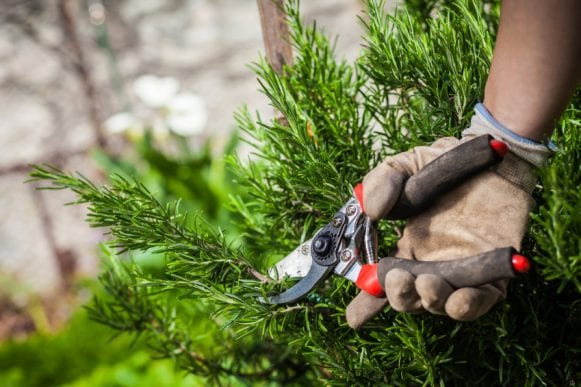As winter fades into spring, gardeners can’t wait to get busy in the garden. Pruning, cutting back perennials and ornamental grasses and preparing the garden for spring planting are just a few of the tasks. Keep yourself and the pollinators overwintering in your garden safe as you start the cleanup process.

Always prune with a purpose. Start by removing any damaged and diseased stems from shrubs and roses. Watch for insects like swallowtail butterflies that overwinter in protective cocoons and the egg masses of some like the hairstreak butterflies. Prevent problems by destroying overwintering non-native pests like the gypsy moth. Search the internet and insect books for help identifying the good and bad guys you may find in your landscape.
Additional pruning may be needed to manage the size and shape or encourage better flowering and bark color. Wait to prune spring flowering shrubs like lilacs and forsythia if you want maximum flowering. Prune these shrubs right after flowering before they set their floral buds for next spring.
Keep yourself safe by wearing safety glasses and gloves. It’s too easy to focus on the task and end up with a stick in the eye. Heavy duty gloves protect and support your hands, allowing you to garden longer with less stress, scratches and bruises.
Lightly rake any debris off the lawn and add it to the compost pile. Check for damage and lightly tamp any disturbed areas back in place. Reseed bare spots so grass, not weeds, fills in these spots.
Brush leaves off the crowns of perennials but leave the rest in place for insects that spend winter or summer in the leaf litter. Plus, the leaves help preserve moisture, suppress weeds and improve the soil as they break down.
Pull mulch away from tree trunks and shrub crowns that may have shifted over winter. Keeping mulch off the stems reduces the risk of future problems that can lead to decline and even death of the plants.
Leave perennials and grasses stand as long as possible since many are homes for beneficial insects. Bundle grasses for easy cutting and removal. Once cut, loosely stack or stand perennial stems and grasses at the edge of the garden or a corner of your yard. This allows any insects still present to safely emerge when it’s time to move to their summer homes. Plus, birds will appreciate the easy access to nesting material.
Enjoy the changing of the seasons and the beauty of nature hidden among the plants in your garden. And keeping the pollinators and other beneficial insects safe will improve your garden’s health and productivity throughout the growing seasons.
Melinda Myers has written more than 20 gardening books, including Small Space Gardening. She hosts the “How to Grow Anything” DVD series and the Melinda’s Garden Moment TV & radio segments. Her web site is MelindaMyers.com.

Related Articles & Free Subscription
A Quality Potting Mix Leads to Gardening Success







Comment here